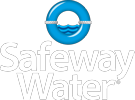What to do if your water smells like sulfur or “rotten eggs”
Hydrogen Sulfide (H2S), best known for its characteristic “rotten egg” odor, is a colorless, very poisonous and flammable gas. The gas is often formed from the bacterial breakdown of organic matter in the absence of oxygen, such as in swamps and sewers (anaerobic digestion). The objectionable odor will blacken plumbing fixtures and blacken painted surfaces while making your water unfit for drinking, household use, and other processes.
Hydrogen Sulfide interferes with water tests and cannot be easily tested in a laboratory. The testing must be done on site because the gas goes away quickly when exposed to air.
Although “rotten egg” smells are commonly called hydrogen sulfide they may actually results from a variety of causes. As mentioned, one common source is the result of the metabolism of bacteria which consume Sulphur. Another source of the offensive smell, prevalent in the hot water side only, is often treatable by simply changing out the sacrificial anode of the home’s hot water heater.
Treatment
The treatment of hydrogen sulfide usually involves oxidizing the gas to allow it to be filtered as a particulate. Standard water treatment oxidants like chlorine, aeration (pressure tank style) hydrogen peroxide, ozone, and potassium permanganate are injected in controlled quantities into the water stream oxidizing the gas and then a specialized filter can filter the remnant particles of the oxidation process, the elemental sulphur.
Another approach for the removal of Hydrogen sulfide may be available using an open tank aeration system in which the contaminant is allowed to escape into the atmosphere. Aeration systems are larger sized tank with shut off floats and repressurization pumps that are vented through screens with atmospheric and environment issues to be concerned with like bugs, lizards and such.
If the problem is slight, the use of catalytic carbon as a stand-alone treatment may be viable. But if the hydrogen sulfide present is significant the carbon filtration will be overwhelmed and will be insufficient as the only treatment. Peroxide injection would be recommended to compliment the Catalytic carbon tank.
Non-chemical Hydrogen Sulfide treatment
Sulfur Shield “oxidizes” the contaminant, converting it to elemental sulfur, so that it can be easily removed by the Sulfur Shield filter. The best filter for the job is carbon, and the specialty carbon called “catalytic carbon” (Centaur or Aquasorb), is the top performer, but when treating the odor alone (when no iron or manganese is present) almost any filter, including a wound string or spun “sediment” filter, can be effective. Carbon block filters work well after Aer-Max if no iron is present. Backwashing carbon or catalytic carbon filters are superb hydrogen sulfide removers after Aer-Max. Virtually any amount of hydrogen sulfide can be treated with Sulfur Shield followed by carbon. With amounts above nine or ten parts per million, however, a treatment tank larger than the standard Aer-Max 10″ X 54″ is recommended.
Request Quote

